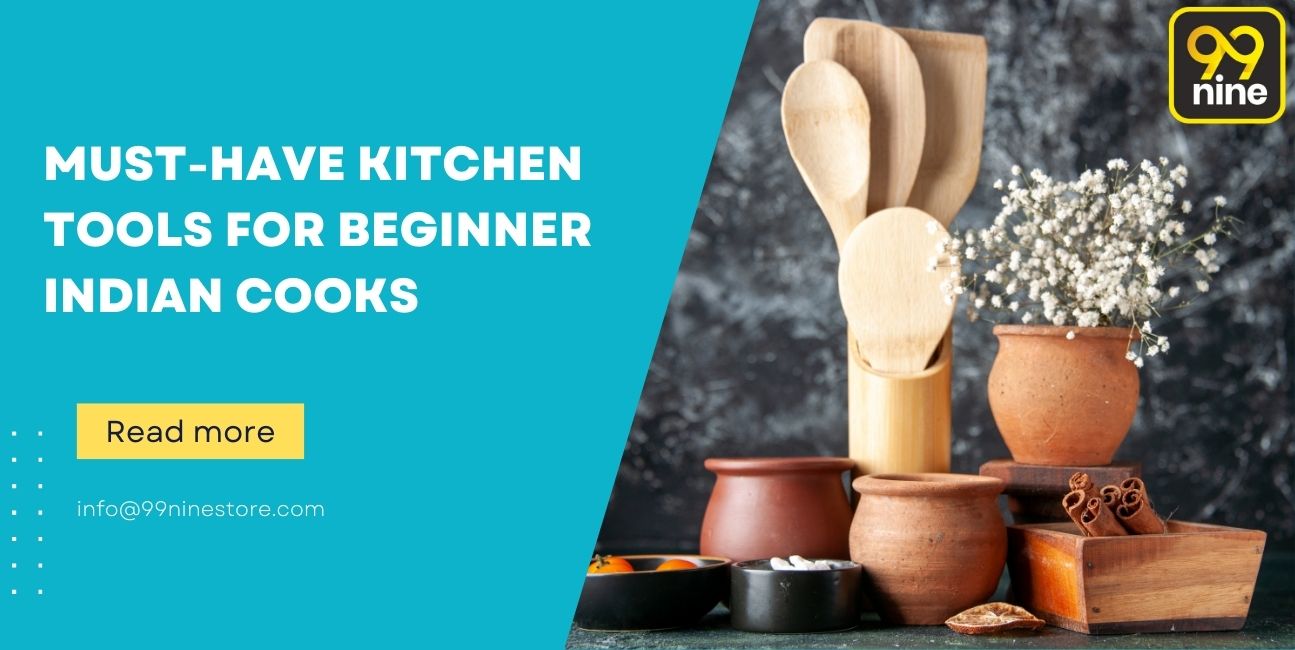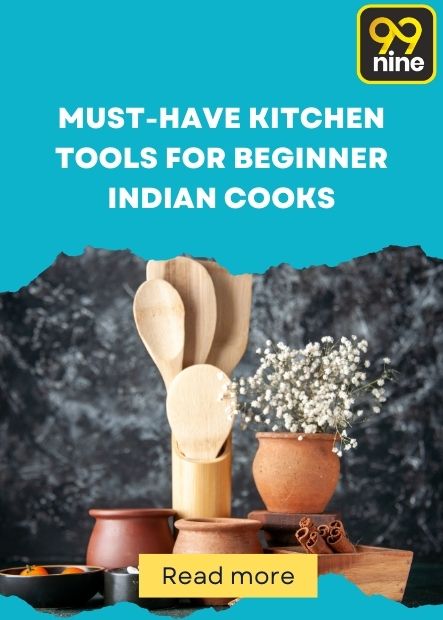

Must-Have Kitchen Tools for Beginner Indian Cooks: Your Complete Shopping Guide
You know that feeling when you walk into a kitchen store and feel completely lost? Rows and rows of gadgets, and you’re thinking – “Do I really need all this stuff to make a simple dal?”
I get it. We’ve all been there! Maybe you just moved out of your parents’ house, or you’re tired of eating Maggi every day (no judgment here!). Whatever brought you to this moment, you’re ready to start cooking real food.
Here’s the thing though – you don’t need to buy half the store to make good Indian food. At 99ninestore, we’ve watched thousands of people walk in confused and walk out confident, knowing exactly what they need for their kitchen setup.
Let’s figure out those must-have kitchen tools for beginner Indian cooks together, shall we?
Why Good Tools Actually Matter (And It’s Not What You Think)
My mom used to make perfect chapatis with her bare hands and a basic tawa. No fancy equipment, just years of practice. But here’s what she never told me – she started with good basic tools too.
When you’re learning must-have kitchen tools for beginner Indian cooks, decent equipment isn’t about showing off. It’s about not getting frustrated and giving up after your third burnt roti.
Think about it – ever tried cutting onions with a dull knife? You end up crying (and not just from the onions), your fingers hurt, and the onions look like a mess. Good cooking utensils and appliances just make everything easier.
Plus, Indian cuisine preparation involves a lot of chopping, stirring, and multitasking. The right kitchen equipment helps you focus on learning recipes instead of fighting with your tools.
Must-Have Kitchen Tools for Beginner Indian Cooks: Let’s Start Simple
Okay, let’s talk about what you actually need. Not what cooking shows tell you, not what your neighbor’s fancy kitchen has – just the real essentials.
Every practical list of must-have kitchen tools for beginner Indian cooks starts with these basics. Your grandma probably had most of these, and they worked perfectly for her.
1. Knives That Won’t Make You Cry
Look, you need good knives. Not Instagram-worthy ones, just sharp, reliable cooking knives that do their job.
8-inch Chef’s Knife: This baby will become your best friend. Chopping onions for curry? Check. Cutting vegetables for sabzi? Check. Mincing ginger-garlic? Double check. It’s literally the foundation of must-have kitchen tools for beginner Indian cooks.
Small Paring Knife: For the fiddly stuff – peeling potatoes, deseeding chilies (carefully!), cutting small garnishes. You’ll use this more than you think.
Bread Knife: Because good bread deserves a good cut, and you’ll thank me when you’re slicing tomatoes without squashing them.
Here’s a reality check – don’t go for the cheapest knives at the local market. They’ll frustrate you more than help. Many families here in Mumbai have told me their 99ninestore knives lasted them years. It’s worth spending a bit more upfront.
2. Cutting Boards (Yes, You Need Two)
Get two cutting boards – one for veggies, one for meat. Trust me on this. Food poisoning isn’t fun, and it’s so easily avoided.
Plastic ones are honestly fine. They’re easier to clean, and let’s be practical here – you’re learning to cook, not filming a cooking show. Pick ones that fit your counter space and won’t slide around when you’re chopping.
3. Cookware That Gets the Job Done
This is where people get overwhelmed. Those fancy 12-piece sets look tempting, but do you really need all that? Let’s be smart about this.
Pressure Cooker (3-5 liters): Non-negotiable. Seriously. This belongs at the top of every list of must-have kitchen tools for beginner Indian cooks. Dal, rice, vegetables, quick curries – this thing does it all. Get a heavy-bottomed one with good safety features.
Non-stick Tawa: For rotis, parathas, dosas. A decent non-stick surface means your rotis won’t stick (as much) while you’re still figuring out the technique. Essential cooking equipment for any Indian kitchen setup.
Deep Kadhai: Perfect for curries, deep-frying, and cooking in larger quantities. Choose one with a thick bottom – it heats evenly and won’t burn your food as easily.
Medium Saucepan: For boiling milk, making chai, cooking small portions. You’ll use this daily.
Kitchen Gadgets That’ll Change Your Life
Technology has made Indian cooking so much simpler. These aren’t fancy gadgets – they’re genuinely helpful tools.
1. Rice Cooker (Trust Me On This)
If you eat rice regularly – and come on, most of us Indians do – get a rice cooker. It’s life-changing and definitely belongs in your must-have kitchen tools for beginner Indian cooks collection.
No more burnt rice at the bottom. No more mushy rice. Just perfect rice, every single time. Some models even handle different types – basmati, brown rice, whatever you prefer.
Just rice, water, button, done. You can focus on making the dal while the rice cooks itself.
2. Electric Kettle (More Useful Than You Think)
Not just for chai! Though let’s be honest, that alone makes it worthwhile. But seriously:
- Boils water way faster than stovetop
- Great for instant noodles (we’ve all been there)
- Speeds up cooking – use hot water to start cooking pasta or blanching vegetables
- Essential for cleaning rice and lentils properly
3. Hand Blender for Real Indian Cooking
This little gadget handles so much. Way more practical than those huge mixer grinders when you’re cooking for 1-2 people. Use it for:
- Smooth tomato puree (game-changer for curries)
- Fresh ginger-garlic paste
- Chutneys – mint, coriander, coconut
- Perfect dal consistency
- Quick lassi or smoothies
Perfect kitchen appliances for efficient Indian cuisine preparation without taking up half your counter space.
Basic Utensils (The Boring But Important Stuff)
These aren’t exciting, but you’ll use them every single day. Every comprehensive guide to must-have kitchen tools for beginner Indian cooks includes these cooking accessories.
Measuring Stuff
- Measuring Cups and Spoons: Indian recipes can be forgiving, but when you’re learning, measurements help. Especially for rice-to-water ratios and spice quantities.
- Kitchen Scale: Not immediately necessary, but helpful if you want to get into baking or be more precise with your cooking.
Stirring and Serving
- Wooden Spoons: Won’t scratch your non-stick pans, don’t get hot like metal ones. Perfect for stirring dal and curries safely.
- Long Ladle: For stirring and serving curries without burning yourself. Get one with a long handle – safety first!
- Tongs: Flipping rotis becomes so much easier. Also great for serving salads and handling hot food.
- Whisk: For smooth batter (dosa, pakora), beating eggs, whipping cream for desserts.
Storage That Actually Works
Good storage isn’t just about looking organized – it keeps your food fresh and saves money. Important components of must-have kitchen tools for beginner Indian cooks.
Containers for Indian Staples
Get different sized airtight containers for:
- Dal, rice, flour (keeps bugs away!)
- Leftover curries and sabzi
- Homemade pickles and chutneys
- Dry spices and masala powders
Clear ones are better – you can see what’s inside without playing guessing games.
Spice Organization (This Matters More Than You Think)
Indian cooking means lots of spices. Staying organized saves time and prevents mistakes.
Try:
- Traditional masala dabba for daily spices
- Small jars for different masala powders
- Drawer organizers if you have the space
- Magnetic containers if your fridge is nearby
Label everything clearly. You don’t want to grab salt instead of sugar for your chai, or mix up cumin with coriander!
Join the Community: Follow us on social media to stay updated on exclusive deals, new arrivals, and tips for better living!
Smart Shopping: Quality vs. Budget
Item | Budget Option (₹200-500) | Mid-Range (₹500-1500) | Premium (₹1500+) | What We Suggest |
Chef’s Knife | Basic steel, needs sharpening often | Good steel, stays sharp longer | Professional quality, lasts forever | Mid-range – best value for beginners |
Non-stick Tawa | 1-2 years max | 3-4 years with care | 5+ years, even heat | Mid-range definitely worth it |
Pressure Cooker | Aluminum, basic | Stainless steel, better safety | Premium steel, multiple safety features | Mid-range for peace of mind |
Rice Cooker | Just on/off | Multiple settings, keep-warm | Smart features, perfect rice | Start mid-range, upgrade later |
Setting Up Without Going Broke
Look, nobody expects you to buy everything at once. Here’s how to be smart about it:
Start Here (₹3,000-5,000)
- Good chef’s knife and cutting board
- Basic pressure cooker for dal and rice
- Non-stick tawa for rotis
- Few wooden spoons and ladle
- Some basic containers
This gets you cooking basic Indian meals. Everything else can wait.
Phase Two (₹2,000-3,000)
- Rice cooker (life-changer!)
- Hand blender for chutneys
- Better storage containers
- Electric kettle
- Maybe a kadhai
Phase Three (₹2,000-4,000)
- Additional cookware as needed
- More specialized utensils
- Measuring tools
- Proper spice organization
- Whatever you realize you’re missing
Real Talk: What Different Cities Need
Every city has its own kitchen culture. Here’s what we’ve noticed helping people find must-have kitchen tools for beginner Indian cooks across India:
- Mumbai folks: Space is everything. Multi-purpose tools win. That pressure cooker better double as a regular pot too.
- Bangalore people: Love their gadgets, and the power supply is reliable enough for electric appliances. Induction-compatible stuff is getting popular.
- Delhi families: Still appreciate traditional materials – brass and copper for certain things. Joint families need bigger quantities.
- Chennai cooks: Equipment needs to handle high heat and humidity. Coconut-heavy cooking means different cleaning needs.
- Kolkata kitchens: Fish preparation needs special boards and tools. Bengali cooking has specific requirements.
Our franchise partners love working with 99ninestore because we get these local differences and stock must-have kitchen tools for beginner Indian cooks accordingly.
Taking Care of Your Stuff
Buying good equipment is step one. Making it last is step two.
Knife Care (Don’t Mess This Up)
- Wash by hand immediately after use
- Dry completely before storing
- Keep them sharp – dull knives are dangerous
- Don’t throw them in drawers with other utensils
Cookware Basics
- Let pans cool before washing (prevents warping)
- No metal utensils on non-stick surfaces
- Clean as you cook – don’t let stuff stick and burn
- Check what’s dishwasher-safe vs hand-wash only
Storage Tips
- Keep containers completely dry before storing food
- Check seals regularly on airtight containers
- Replace anything that’s cracked or damaged
- Clean spice containers occasionally – oils can go rancid
Building Your Confidence
Having the right cooking equipment helps, but confidence comes from practice. Here’s what’s worked for thousands of people learning to use must-have kitchen tools for beginner Indian cooks:
- Start ridiculously simple: Perfect dal and rice before attempting biryani. Master one thing completely.
- Repeat, repeat, repeat: Make the same dal three times. Notice how much easier it gets with practice and proper tools.
- One technique at a time: Get comfortable with pressure cooking before trying to deep fry. Your kitchen equipment will work better when you understand it properly.
- Mistakes happen: Everyone burns food sometimes. Over-salted curry usually has a fix. These experiences teach you more than any cookbook.
Why People Choose 99ninestore
At 99ninestore, we’ve helped thousands of families get started with must-have kitchen tools for beginner Indian cooks. What makes us different?
- We get Indian cooking: Our product selection actually reflects what people need for regional Indian cuisines, not just generic cooking equipment.
- Fair pricing: Good cooking tools shouldn’t cost a fortune. We offer reliable kitchen appliances and utensils that don’t break budgets.
- Real guidance: Our staff cooks too. We can actually advise you on kitchen tools that match your cooking style, space, and regional needs.
- Franchise opportunities: Love what we do? Many of our franchise partners started as customers who appreciated our approach to making essential cooking equipment accessible to Indian home cooks.
Mistakes Everyone Makes (Learn From Others)
We see these happen constantly with people buying must-have kitchen tools for beginner Indian cooks:
- Buying everything at once: You’ll end up with gadgets collecting dust. Buy what you need now, add later.
- Choosing pretty over practical: That gorgeous copper pot is useless if you can’t maintain it properly.
- Ignoring maintenance: Best cooking equipment fails without proper care.
- Not measuring your space: That giant appliance won’t help if it doesn’t fit in your Indian kitchen setup.
- Always buying cheapest: Some kitchen equipment is worth spending slightly more for safety and longevity.
FAQ
FAQs About 99nine Store
Honestly? Good chef's knife, cutting board, and pressure cooker. These three will let you make basic Indian meals. Everything else can wait. That's about ₹2,500-3,000 total, and you can cook dal, rice, and simple vegetables. Add a tawa next for rotis.
Yes! Food poisoning is no joke. Raw meat bacteria getting on vegetables you eat raw (salads, garnishes) can make you seriously sick. Get two plastic boards – easier to sanitize than wooden ones.
Individual knives, definitely. Most sets include specialty knives you'll never use for Indian cooking. Start with a good chef's knife for vegetables and ginger-garlic prep, add a paring knife for detail work like deseeding chilies.
5-liter works perfectly. Big enough for family portions of dal, rice, and vegetables, but not so huge it's hard to handle. You can cook smaller amounts in a bigger cooker, but you can't fit more in a small one.
When the coating starts peeling or food sticks even with oil/ghee. Don't risk eating coating flakes – not safe. With daily Indian cooking use, expect to replace every 2-3 years. It's a consumable, not a lifetime purchase.






